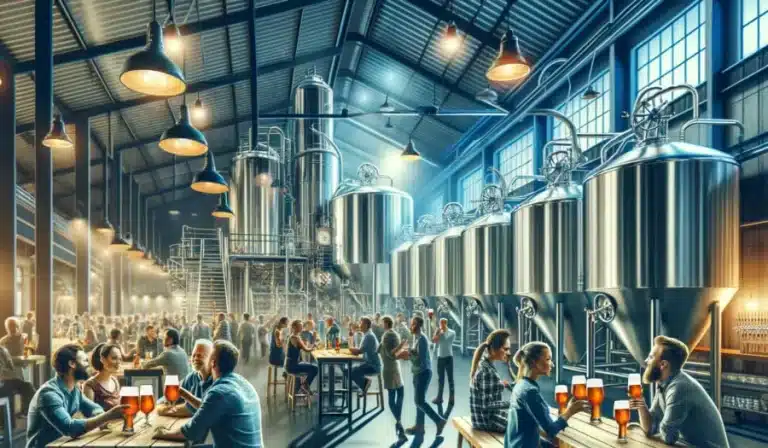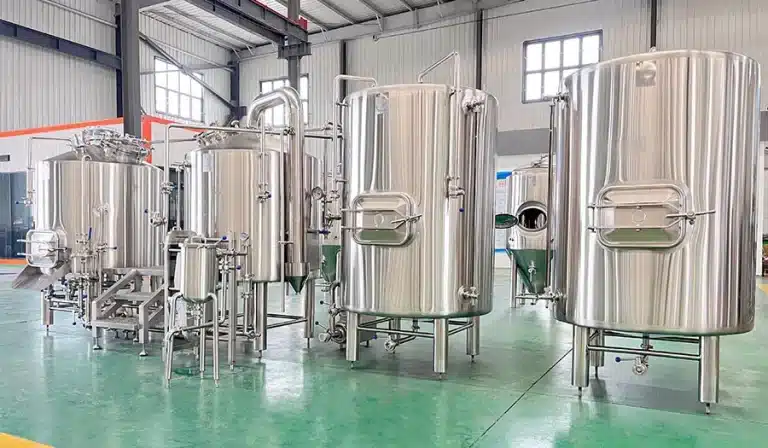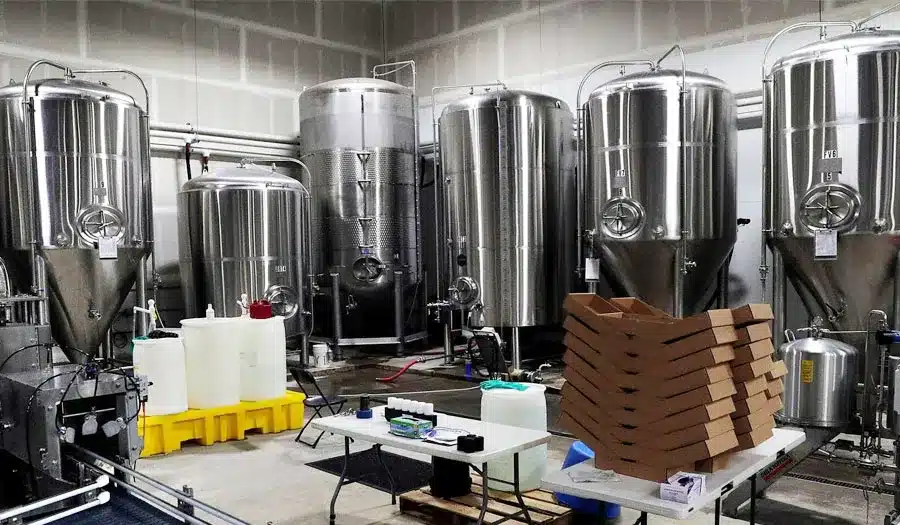Con el desarrollo de la industria cervecera artesanal, la cerveza artesanal es cada vez más popular y aceptada por la gente. La cerveza artesanal enfatiza la elaboración a mano, el sabor único y el gusto innovador, por lo que la selección del equipo de elaboración de cerveza artesanal es crucial para la producción de las cervecerías artesanales. Este artículo detallará los principales equipos de elaboración de cerveza requeridos por las cervecerías artesanales, y discutirá cómo elegir el equipo adecuado para satisfacer las necesidades de elaboración de cerveza de diferentes escalas y estilos.
Proceso de elaboración de la cerveza artesanal
- Preparación de la malta: Moler la malta de cebada u otros granos y prepararlos para el macerado.
- Triturar: Mezclar malta con agua y calentarla para extraer azúcar y producir mosto.
- Hervir: Calentar el mosto hasta ebullición, añadir lúpulo y otros ingredientes, y hervirlo para extraer amargor y aroma.
- Fermentación: Enfriar el mosto hervido, añadir levadura para iniciar la fermentación y convertir el azúcar en alcohol.
- Postfermentación y envasado: Tras la fermentación, la cerveza se aclara, madura, filtra y envasa para completar la producción de la cerveza artesana final.

Sistemas de elaboración de cerveza necesarios para las cervecerías artesanales
- Molinillo de malta: Los molinillos de malta son el equipo más básico en las cervecerías artesanales. Su función principal es ser uno de los grandes trituradores de malta de cebada, que puede liberar mejor el azúcar durante el proceso de maceración. La malta triturada se denomina "harina de trigo", que debe estar triturada de manera uniforme y no demasiado fina para garantizar que pueda entrar en contacto con el agua sin problemas y convertirse en azúcar soluble durante el proceso de maceración.
- Sistema de maceración: la maceración es un paso crítico en la cerveza artesanal, que determina el sabor y el contenido de alcohol de la cerveza final. El sistema de maceración incluye principalmente una olla de maceración, un tanque de maceración y un sistema de control de la temperatura. La olla de maceración es un dispositivo que mezcla harina de trigo con agua caliente y la calienta a una temperatura controlada para convertir el almidón en azúcar.
- Sistema de filtración: El sistema de filtración suele formar parte del equipo de maceración y se utiliza para separar el mosto producido tras la maceración de los granos usados. Este proceso se denomina "escorificación", que puede eliminar los granos usados y los sólidos no convertidos, dejando un mosto claro.
- Sistema de enfriamiento: Después de la ebullición, el mosto debe enfriarse rápidamente para que pueda entrar en la fase de fermentación tras la adición de levadura. Existen dos tipos principales de sistemas de refrigeración: enfriadores de placas y enfriadores de tubos.
- Sistema de fermentación: El sistema de fermentación se encarga de convertir el mosto sacarificado en alcohol. La levadura se somete al proceso de fermentación en el fermentador, convirtiendo el azúcar en alcohol y fermentando. El fermentador suele ser de acero inoxidable con un buen sellado y control de la temperatura.
- Sistema de limpieza: Un sistema de limpieza fiable es esencial para mantener la higiene del equipo de elaboración de cerveza. Una limpieza e higienización adecuadas evitan la contaminación y garantizan la consistencia del producto final.
Piezas importantes del equipo de cerveza artesanal
Hervidor de cerveza
Un hervidor de cerveza es un recipiente de gran tamaño que se utiliza para hervir el mosto y que se presenta en varios tamaños para adaptarse a diferentes lotes. Se trata de un paso clave en el proceso de elaboración, en el que se añade lúpulo para aportar amargor y aroma a la cerveza. Estas ollas suelen ser de acero inoxidable o cobre. La composición del material del tanque de elaboración de cerveza es el principal factor a tener en cuenta, y tanto el cobre como el acero inoxidable son buenas opciones. Aunque el acero inoxidable es menos caro y requiere menos mantenimiento, el cobre proporcionará un mejor sabor a la cerveza debido a su capacidad catalítica. Sólo depende de cuánto esté dispuesto a gastar y de lo que quiera.
Barril filtrante
El barril filtrante se utiliza para separar el residuo sólido (residuo de malta) del mosto. Su principio de funcionamiento consiste en utilizar una malla o placa filtrante en el fondo para separar el mosto (residuo de malta) del residuo de malta mediante el flujo de líquido. Este paso sirve para obtener un mosto claro. Los filtros de cerveza se utilizan para eliminar aún más las partículas diminutas, como la levadura y los residuos de malta, con el fin de garantizar la frescura y el sabor de la cerveza. Dependiendo de los distintos métodos de elaboración, la cerveza puede filtrarse gruesa o finamente.

Caldera
La caldera se utiliza para calentar el mosto hasta el punto de ebullición y añadir lúpulo durante el proceso. El lúpulo libera componentes amargos y aromáticos durante el proceso de ebullición, y también tiene un efecto esterilizador, garantizando la seguridad del mosto. El tiempo y la temperatura de ebullición del lúpulo son fundamentales para el amargor, el aroma y el sabor del lúpulo.
Enfriador de mosto
Tras la ebullición, el mosto caliente debe enfriarse rápidamente antes de añadir la levadura para la fermentación. Un enfriador de mosto puede reducir eficazmente la temperatura del mosto para evitar la contaminación y los olores desagradables. Elija un equipo con una alta eficiencia de enfriamiento para reducir el tiempo que el mosto está en un entorno con una temperatura inadecuada.
Fermentador
El fermentador es el lugar donde se produce la magia de la fermentación. La levadura convierte los azúcares en alcohol y dióxido de carbono, y el fermentador proporciona un entorno controlado para este proceso. Estos tanques son esenciales para determinar el perfil de sabor y el contenido de alcohol de la cerveza. Los barriles o barriles de fermentación son esenciales para cualquier entorno de elaboración de cerveza casera. La cerveza puede fermentarse en una gran variedad de recipientes, desde barriles de plástico hasta botellas de cristal. Durante el proceso de fermentación, los azúcares de la levadura se convierten en alcohol y agentes fermentadores. Según el tipo de fermentación, el tanque de fermentación se divide en un tanque de fermentación superior (para producir cerveza ale) y un tanque de fermentación inferior (para producir cerveza lager).
Equipos de envasado
Los equipos de envasado para cerveza artesanal incluyen sistemas de embotellado, enlatado y barrilado. El equipo de envasado incluye máquinas envasadoras automáticas, taponadoras, etiquetadoras, etc., que pueden mejorar la eficiencia de la producción y garantizar la calidad de la cerveza. Las formas más comunes de envasado de cerveza incluyen botellas, latas y barriles.
¿Cómo elegir el equipo adecuado para la cerveza artesanal?
Escala y capacidad de producción de la fábrica de cerveza
La elección del equipo debe determinarse en función del tamaño de la cervecería y de la capacidad de producción prevista. Las pequeñas cervecerías artesanales pueden elegir equipos de menor escala para un funcionamiento manual y un ajuste flexible, mientras que las grandes cervecerías requieren equipos más eficientes y automatizados para satisfacer las necesidades de la producción en masa.
Materiales y estructuras
La elección de materiales y estructuras afectará a la durabilidad y los requisitos de mantenimiento del equipo. El acero inoxidable es popular por su larga vida útil y su resistencia a la corrosión.

Presupuesto y coste
La inversión en equipos es un coste a largo plazo, por lo que hay que tener en cuenta la importancia del presupuesto y de los equipos a la hora de seleccionarlos. Aunque la calidad y el rendimiento de los equipos de gama alta suelen ser mejores, también es necesario evaluar si se ajustan a la escala y la producción prevista de la cervecería.
Asistencia técnica y servicio posventa de equipos
La calidad de los equipos es muy importante, pero lo más importante es saber si el proveedor ofrece un servicio posventa y una asistencia técnica completos. Asegúrese de que el proveedor del equipo puede ofrecer a tiempo servicios de reparación, mantenimiento, actualización y otros, y evite también que la producción se vea afectada por fallos del equipo.
Mantenimiento y limpieza del equipo de elaboración de cerveza artesanal
- Inspección y mantenimiento periódicos: Las inspecciones periódicas de los equipos de elaboración de cerveza son necesarias para descubrir y resolver posibles problemas antes de que se agraven. La aplicación de un plan de mantenimiento mantiene el equipo en óptimas condiciones, reduce el riesgo de averías y garantiza una calidad constante de la cerveza.
- Procedimientos de limpieza y mejores prácticas: Una limpieza y desinfección minuciosas son esenciales en el proceso de elaboración de cerveza para evitar la contaminación y los malos olores. Desarrolle y siga procedimientos de limpieza estrictos para todo el equipo, a fin de garantizar que esté libre de bacterias y otros contaminantes.
- Pueden producirse problemas en los equipos a pesar de un mantenimiento meticuloso. Familiarícese y familiarice a su equipo con las técnicas habituales de solución de problemas para resolverlos rápidamente y minimizar el tiempo de inactividad.
PREGUNTAS FRECUENTES
¿Cuánto cuesta el equipo para fabricar cerveza artesanal?
El coste de los equipos de elaboración de cerveza artesana puede variar enormemente en función del tamaño y la complejidad de la fábrica. Los pequeños equipos de elaboración casera pueden costar cientos de dólares, mientras que las cervecerías comerciales pueden requerir inversiones de decenas de miles de dólares o incluso más.
¿Qué equipamiento básico necesita una fábrica de cerveza artesanal?
El equipo básico de elaboración de cerveza incluye un molinillo de malta, una cuba de maceración, una cuba de filtración, una olla de ebullición, un enfriador, un tanque de fermentación, un equipo de llenado y un equipo de limpieza y desinfección.
¿Qué materiales se utilizan habitualmente en los equipos de las cervecerías?
El acero inoxidable es el material más utilizado en los equipos de elaboración de cerveza por su durabilidad, resistencia a la corrosión y facilidad de limpieza.
¿Cómo elegir un depósito de fermentación adecuado?
A la hora de elegir un tanque de fermentación, hay que tener en cuenta el lote de elaboración, el control de la temperatura de fermentación y si es necesaria una fermentación secundaria. Al mismo tiempo, el material también afectará a la calidad de la cerveza. El acero inoxidable suele ser la elección más adecuada.




